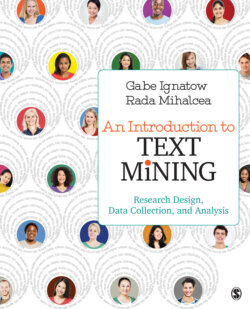Читать книгу An Introduction to Text Mining - Gabe Ignatow - Страница 26
На сайте Литреса книга снята с продажи.
Key Terms (see Glossary)
ОглавлениеConcordance 5
Content analysis 5
Conversation analysis 6
Critical discourse analysis (CDA) 6
Digital archives 15
Disambiguation 4
Discourse positions 6
Foucauldian analysis 6
General Inquirer project 5
Natural language processing (NLP) 4
Netnography 14
Sample bias 12
Sentiment analysis 4
Text analysis 3
Text mining 3
Virtual ethnography 14
Web crawling 4
Web scraping 4
Highlights
Text mining processes include methods for acquiring digital texts and analyzing them with NLP and advanced statistical methods.
Text mining is used in many academic and applied fields to analyze and predict public opinion and collective behavior.
Text analysis began with analysis of religious texts in the Middle Ages and was developed by social scientists starting in the early 20th century.
Text analysis in the social sciences involves analyzing transcribed interviews, newspapers, historical and legal documents, and online data.
Major approaches to text analysis include analysis of discourse positions, conversation analysis, CDA, content analysis, intertextual analysis, and analysis of texts as social information.
Advantages of Internet-based data and social science research methods include their low cost, unobtrusiveness, and use of unprompted data from research participants.
Risks and limitations of Internet-based data and research methods include limited researcher control, possible sample bias, and the risk of researcher passivity in data collection.
